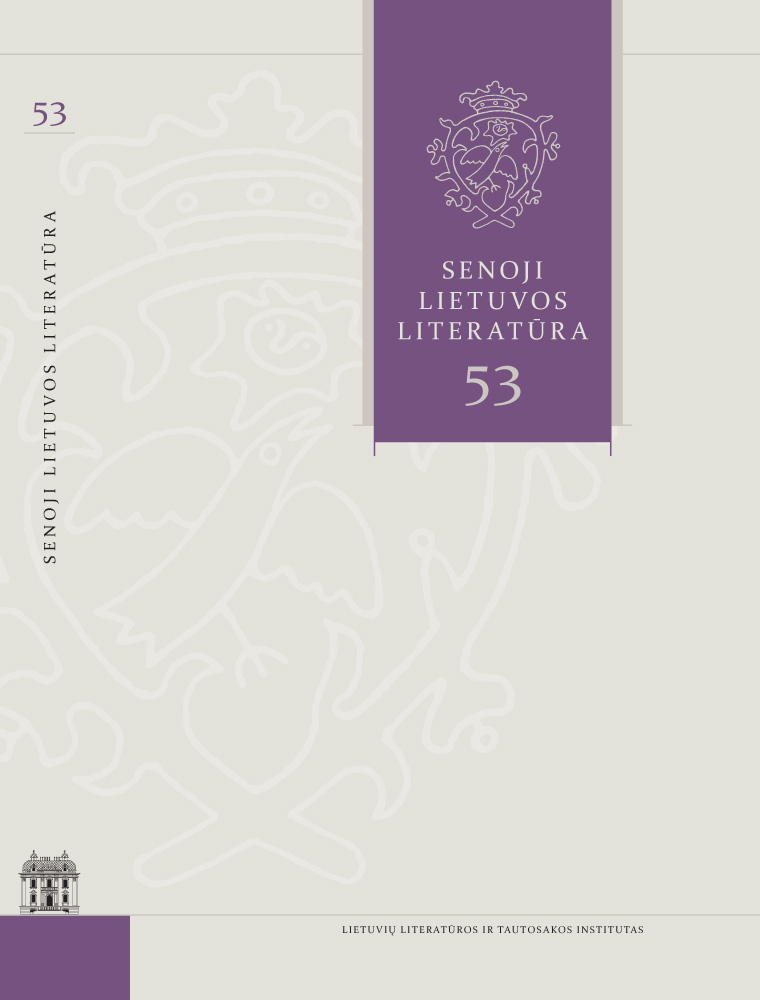Laurentius Boierus a Representative of Greek Literature in the Grand Duchy of Lithuania
Abstract
This article is devoted to the reconsideration of the contribution of Laurentius Boierus (Lars Bojer, c. 1561–1619), a famous Swedish erudite of the second half of the sixteenth-early seventeenth century, a polyglot and poet (poeta laureatus), to the cultural life of the Grand Duchy of Lithuania. To this end, it draws on various well-known and less frequently mentioned data from biographers, bibliographers, and historians who have collected archival material, on the one hand, and on new literary findings and observations, on the other. The main focus of the paper is on elucidating the attempts of the pen of this representative of neo-Latin literature, best known as the author of the Baroque poem Carolomachia (Vilnius, 1606), at Greek. It analyses in detail two Greek texts that have a dedicatory or ‘threshold’ function in the Latin edition of Chalecki’s Allegoriae (Vilnius, 1618): the epigram ‘Εἰς τὸ βιβλίον’ and the ‘anagram of the author’. These Greek texts were recently discovered and for the first time briefly identified in a recent study on the devotional and mystical insights of Nicolaus Christophorus Chalecki, a nobleman of the Grand Duchy of Lithuania, published in the edition of his Allegoriae and Binarius Chalecianus (Vilnius: Vilnius Academy of Arts, 2020). On the basis of the previous reconstruction of the letters of the anagram and with the help of new material, it is now argued with greater certainty that the author of the Greek epigram is Laurentius Boierus (Greek: Λαυρέντιος Βωιῆρος). The article presents not only the hypothetical principle of deciphering the anagram, but also several textual arguments and facts that support the hypothesis of the authorship. Here the parallel with the Latin anagram on Laurentius Boierus’s name preserved in Bartholomew Bilovius’s collection of anagrams (Erfurt 1614), is of particular importance. The Greek epigram examined in this article reveals its author’s rhetorical erudition, his interest in correct rhyming, and his subtle fascination with the play of meaning and form, especially with ingenious epithets, neologisms, and subtle allusions to rare ancient literary sources. Moreover, the stylistic devices used in the poem allow us to hypothetically compare this text with other Greek texts that appeared in the milieu of Lithuanian Jesuits, especially at the Nesvizh College, where Boierus worked for a year as a professor of rhetoric. Without claiming to be exhaustive, the article also contributes to a number of broader or very specific issues, such as the influence of Boierus on the cultural and pedagogical activities of Lithuanian and Polish Jesuits, the identification of his poetic heritage, the concealment of his authorship, and the ambiguity of the attribution of a surviving Latin mathematical treatise to him. For the first time, this paper draws attention to the importance of Greek studies for the erudition of this poet and reflects on his possible contacts with Greek teachers in the Jesuit environment. The article concludes with the observation that Boierus’s Latin works may provide additional arguments about his (phil)hellenism, but this should be the subject of another paper.

This work is licensed under a Creative Commons Attribution 4.0 International License.
